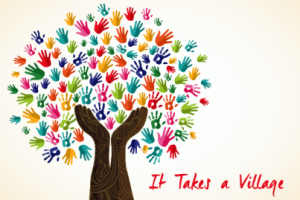NJ Teachers of English to Speakers of Other Languages/
NJ Bilingual Educators
Bilingual Elementary SIG Representative: Alamelu Sundaram-Walters- Bridging Cultures
Bilingual/ESL Middle School SIG Representative: Michelle Land- Be the Village
Early Childhood SIG Representative: LeighAnn Mathews- End-of-the-School Year Reflections
ESL Secondary SIG Representative: Hana Prashker- Three Aha Moments- HS Students Writing
Higher Ed SIG Representative: Diana Sefchik- Talking Points for the Next Generation of Statewide Assessments for ELLs
Higher Ed SIG Representative: Diana Sefchik- Effective Vocabulary and Reading Comprehension Development Strategies
Parent and Community Action SIG Representative: Angeline Sturgis- The Look
Special Ed SIG Representative: Sonya Bertini- Navigating the World of Special Education
Summer 2018 Features: Reflections and Looking Forward

Bilingual Elementary 1-8 Special Interest Group
Bridging Cultures
By Alamelu Sundaram-Walters
“Everyone smiles in the same language.”
This is a quote that I once saw outside a classroom and have kept as my mantra when teaching English to my students.
So where did it all begin?
Both my parents were studying in medical school in Chennai, a coastal region in South India. They had recently married. At the time, arranged marriages were common in the Hindu culture. However, my parents were one of a few who chose differently; they chose each other. Though this was unacceptable in the Hindu culture and, especially in our family, my parents knew that they needed to challenge the standard cultural practice. Just a few years later, my parents embarked on a journey that would forever change their lives. They immigrated from Chennai, South India, to New York City to complete their studies, begin medical residencies, and raise a family. When they decided to move to America, they left everyone they knew, family and friends. This strength of character and understanding was passed down to their children.
My parents, two siblings, and I lived in an walk-up apartment in Brooklyn Heights, New York. I would later spend most of my adolescent years in Staten Island, where I felt I never quite fit in. My years there, as an adolescent from an immigrant family in a place where there were not too many South Asians, were a struggle. It was difficult at times as a young adult trying to assimilate.
I graduated from Drew University in Madison, New Jersey, where I majored in Anthropology and minored in Spanish. While in college, I traveled to Bolivia during my junior year through the School for International Training. I also involved myself in various service projects. Traveling and service have always been, and continue to be, the forces that drive me and guide me as a teacher. I knew after traveling to Bolivia and volunteering at an orphanage in Honduras that I would love to pursue a career in education. Therefore, I decided to go back to school and I earned my Master in Language Education from Rutgers University. However, I spent many years working in New York in an art gallery before taking on a teaching job. All of these experiences would support me as a novice teacher.
After graduating from Rutgers University, and having an amazing student teaching experience at Redshaw Elementary School in New Brunswick, I accepted a position as an English as a Second Language teacher at Public School 16, John D. Driscoll. This would be my first job for three and a half years.
In time, I moved to South Jersey. In Mt. Laurel, I took a job as a traveling ESL teacher. At first, I did not know what being a traveling teacher would entail, but I was eager to learn. After 10 plus years, I have grown into my position. I have definitely found my niche, my home away from home. By advocating for my students, collaborating with colleagues and bridging parents and schools, my involvement has shaped who I am professionally as well as personally. I bring these to my classroom on a daily basis, while continuing to learn and grow in my profession.
As I shared earlier, “Everyone smiles in the same language.” When you empathize and provide rich and meaningful opportunities for all children and advocate for them, everyone benefits, leading to those smiles.
Alamelu Sundaram-Walters, Bilingual Elementary 1-8 Representative, Mount Laurel School District/ESL Teacher
Bilingual Middle School Special Interest Group
Be the Village
By Michelle Land
“It takes a village” is quoted often when we think about what is necessary to empower our children to become positive members of society. The responsibility and involvement of our society in children’s lives are essential in today’s fast-paced and over-stimulating world. The education of our students is also the responsibility and involvement of all facets of our schools.
Cross-curricular teaching defined is “denoting or relating to an approach to a topic that includes contributions from several different disciplines and viewpoints.”1 It has been the new wave for several years, but the power behind the wave is still going strong. That is because cross-curricular approaches to education provide for deeper learning which is beneficial to students in all aspects of their academic careers.
Ben Johnson, in his Edutopia article, argues, “… deeper learning can be accelerated by consolidating teacher efforts and combining relevant contents, in effect, opening new spillways of knowledge.”2 This goal is facilitated by cross-curricular teaching but how does it benefit English language learners (ELLs)?
The education of our ELLs cannot occur in a bubble. Our role as educators of ELLs is to help them achieve English proficiency that will allow them to meet with academic success in the mainstream classrooms. Thus, it was timely and appropriate that the NJTESOL/NJBE Spring Conference focused on “Cross-Curricular Conversations for ELLs”.
There were cross-curricular conversations taking place all over the New Brunswick Hyatt during the conference. There were workshops from classroom teachers, bilingual teachers, and ESL teachers. There were workshops given by special education teachers, science teachers, yoga instructors, and the list goes on. Their common goal was to be the village for ELLs.
From the lunchroom staff to the administrators, nurses to the health teachers, kindergarten to the high school teachers, we are the world for ELLs. These students are negotiating a path through unfamiliar hallways. When we work together, we are guides to their learning and their choices. If we restrict ourselves to our small corner of the world as educators, we limit how far our students can imagine their journey will take them.
Some cross-curricular opportunities are obvious, such as language arts and social studies, science and math. Others are elusive, but just as meaningful, such as art and language arts, science and culinary arts. By cooperating and collaborating, students can express themselves in a variety of ways that they may not have been able to do previously.
Another benefit to cross-curricular teaching is the opportunity to share valuable and successful learning strategies and scaffolding techniques. As strategies become routine and comfortable for ELLs, these students are able to focus more on content in a safe and manageable environment.
By working together with a common vision, using an established and consistent methodology, students are exposed to cross-curricular, deeper learning that is connected in a variety of ways. The learning objectives and expectations will provide the framework for the educator(s) while the interactive cross-curricular approach will challenge, enlighten, and support English language learners.
Michelle Land is the NJTESOL/NJBE Bilingual/ESL Middle School 6-8 SIG Representative. She teaches ESL at Randolph Township Schools.
1 http://www.dictionary.com/browse/cross-curricular
2 https://www.edutopia.org/blog/cross-curricular-teaching-deeper-learning-ben-johnson

Bilingual and ESL Early Childhood Special Interest Group
End of the School Year Reflections
By LeighAnn Matthews
Can it really be June already? It seems as if this school year has flown by. As I wrap up yet another year of teaching, I definitely find myself feeling “teacher tired”, but also extremely reflective. This has most certainly been a year of professional growth and success. When I think about my educator journey over the past year, I realize that much of my growth and success is all thanks to my colleagues within New Jersey Teachers of English to Speakers of Other Languages/New Jersey Bilingual Educators (NJTESOL/NJBE), and to the educators I have met through the organization and consider my mentors.
It was wonderful to connect with so many of you at this year’s NJTESOL/NJBE Spring Conference. I always leave the conference feeling excited and refreshed from all of the positive energy that surrounds the workshops and topics that are discussed. The passion of all who attend is always so evident. I enjoyed hosting two ESL/bilingual early childhood “hot topics” sessions. As I shared with those who joined me during the sessions, one of my goals is to establish a strong Special Interest Group (SIG). I truly believe in the power of collaboration and I think we can really learn a lot by staying in touch with one another beyond the NJTESOL/NJBE Spring Conference. Being a member of NJTESOL/NJBE is a great way to meet other educators that have similar passions, interests, and will inspire you to grow as an educator.
I hope that everyone finished their school year on a high note and has a relaxing summer. I know I will be spending many afternoons on the beach reading and preparing for September. If you are interested in collaborating with other ESL/bilingual early childhood educators within NJTESOL/NJBE or have any questions, please contact me.
LeighAnn Matthews is the NJTESOL/NJBE Bilingual and ESL Early Childhood SIG Representative. She is a Pre-K–2nd grade ESL teacher in Highland Park Public Schools.
 ESL Secondary Special Interest Group
ESL Secondary Special Interest Group
Three Aha Moments
By Hana Prashker
Dr. Malcolm Butler was the keynote speaker on Thursday, May 31st, at the NJTESOL/NJBE (New Jersey Teachers of English to Speakers of Other Languages/New Jersey Bilingual Educators) Spring Conference. I was able to hear the last half of his presentation. Just after I walked in, he used the verb “document” in reference to students documenting their thoughts and ideas through illustration and words. He gave examples of famous scientists who documented their thought processes, such as Thomas Edison, Leonardo DaVinci, and Galileo. He showed pages from their notebooks, not journals, with pictures and words that they understood.
Dr. Butler discussed having students document their predictions using pictures, words, or sentences. After completing the science text or lab, students review their original predictions to see if they were accurate. If not, they create another document to show what actually happened or, possibly, why the prediction was incorrect. (I find doing this with texts in English Language Arts (ELA) classes, elicits connections to students’ prior knowledge. They seem to focus more in order to decide if their predictions are correct.) Working in a secondary science classroom, there is a real need to model this process so that English language learners (ELLs) can demonstrate understanding, even at the beginning level.
Dr. Butler also used the words science notebooks, as opposed to science journals. Notebook has a more academic association than journal does. Students and teachers make take the documenting more seriously if students are documenting in their science notebooks.
The final takeaway from Dr. Butler’s presentation was allowing students to write about their understanding of a science topic in a variety of formats – giving students choice. For science, students could write using an expository, narrative, persuasive, or descriptive style of writing to demonstrate understanding.
I am hoping that the more academic words, document and notebook, as well as the examples that Dr. Butler gave, will make secondary science teachers change their perspectives on the ways ELLs can demonstrate understanding.
Here is the link to the presentation for the ESL Secondary Special Interest Group (SIG) meeting. Please remember that directives from the NJDOE continue to change. http://njtesol-njbe.org/wp-content/uploads/2018/05/h18_ESL_Secondary_Hot_Topics.pdf
I hope all of you take time this summer to relax and refill your souls with energy for the next school year.
Hana Prashker is the NJTESOL/NJBE ESL Secondary Representative. She teaches ESL at Dumont High School, Bergen County.
Higher Education Special Interest Group
The Talking Points for the Next Generation of Statewide Assessments for English Language Learners
By Diana Sefchik
The Higher Education Special Interest Group (SIG) met on Friday, June 1, 2018, from 1:00 pm-2:15 pm. Fourteen educators, in different positions involving higher education programs around the state of New Jersey, attended. The SIG attendees discussed their programs and the issues faced, such as how we can retain our students and reduce attrition. Our students enter from varied backgrounds, from different home and work situations, and their ages range from 18 to 65 years old. The SIG attendees shared information on registration and placement procedures around the state and effective strategies of instruction in the classes themselves.
Placement procedures became our springboard for discussion about the Talking Points for the Next Generation of Statewide Assessments for English Language Learners (ELLs) and the connections needed from secondary education ELL testing to entrance in higher education institutions. As the participants in the SIG discussed, throughout the State of New Jersey, the requirements for entrance/placement are “similar but different.” The Accuplacer and/or the Accuplacer ESL are used while other institutions have designed “homegrown” placement tests for ELLs. Criteria and rubrics vary throughout the state. This discussion was a vital step in looking at how ELLs are placed once they graduate high school. We also focused on the over-testing of ELLs and the need for streamlining and revising assessment procedures.
The Higher Education SIG plans to meet with the other groups such as the Higher Education ESL Coordinators Group and secondary representatives to discuss the high school graduation requirement for ELLs and then discuss how these graduation requirements “will feed into” placement into county colleges. Recommendations will be made to the New Jersey Department of Education.
There is much work yet to do but this is an exciting time in the realm of higher education.
In addition to our discussion, information from two conferences was shared with the Higher Education SIG attendees. In May, the New Jersey Association for Lifelong Learning (NJALL) Conference and The Best Practices Conference were held. The conferences discussed the preparation of adult ELLs for the changing job market. Other talking points were how to align higher education curriculum with K-12 curriculum, retain students, balance non-credit / credit courses, and foster workforce development.
Statistics were shared about county college students:
- 325,000 students are enrolled
- 62,000 take non-credit students
- 23, 557 earn degrees from county colleges
At the Best Practices Conference the ending question was, “Looking ahead to the next five to ten years, what are the most promising opportunities for New Jersey’s community colleges?”
This is a powerful question and ties into our overall talking points of placement and assessment of ELLs from high school to county colleges.
Diana Sefchik, Higher Education SIG Representative, Raritan Valley Community College, Seton Hall University

Higher Education Special Interest Group
Effective Vocabulary and Reading Comprehension Development Strategies
By Diana Sefchik
On Friday, June 1, at 10:00 am, higher education instructors met to discuss what true and effective strategies of instruction are used in our adult English Language Learner (ELL) classes. The discussion started with a review of what reading passages are used in class and how, sometimes, our selection of passages present ambiguous syntax and vocabulary. This recommendation was made among the educators: make sure you read and re-read the passages before you present the material to the students. Be aware of multiple-meaning words.
Samples from novels such as To Kill a Mockingbird and Having Our Say-The Delaney Sisters were reviewed. The goal is to get students to read academic material; the question is how to get the students prepared for academic reading. Reading between the lines was reviewed as the attendees worked through the passages and selected vocabulary to help indicate the time periods, the location, the characters, and the genre of the reading passages.
Poetry was presented as an alternative way of combining grammar and vocabulary in a rhymed passage. Shel Silverstein’s works lend themselves to style, and review of nouns and adjectives through wit. As we read poetic passages, we acknowledged the need to often revisit phrasal verbs, vocabulary chunking, nouns, adjective endings, use of articles, transfer of language, innuendos, and clichés.
As we were ending our close examination of a newspaper and other printed samples, we brainstormed about how all these pieces fit to build a language to help students develop vocabulary; how we can incorporate vocabulary development by reading between the lines; and what books are being used. We reiterated that we have our obligations as teachers: we need to be well read and aware of print. We need to include life experiences and social media educationally to help develop vocabulary.
Using a variety of printed material in our adult ESL classes can help our students see academic reading – and reading overall- as a way to develop their vocabulary usage and to become a part of all types of discussions. We, as teachers, have to decide how much time we spend on vocabulary development. If we give our students the tools to develop vocabulary independently, they will be able to soar in their overall language acquisition.
Diana Sefchik, Higher Education SIG Representative, Raritan Valley Community College, Seton Hall University

Parent and Community Special Interest Group
The Look
By Angeline Sturgis
There is a newcomer child in my kindergarten English as a Second Language group that I will call “Juliet.” Juliet wants to be perfect. Her hesitation when writing and her reluctance to answer questions are two examples of her insecurity with English. When I speak to her, or even make eye contact with her, she looks down, or she looks up, or she stares straight at me and doesn’t change her expression for as long as I let it go on. Juliet is not interested in risk-taking. She is not up for the thrill of new experiences or a good laugh at a wild guess. She knows how to be quiet and well-behaved and make her parents happy. I know this, and, over this school year, I have worked out ways to help Juliet feel safe enough to take a chance. I have welcomed her shy smiling at my enthusiastic cheerleading. I know when to wait, when to praise, and when to get loud and crazy. A few weeks ago, I made up the “Juliet Cheer” and all the kids in her group enthusiastically joined in, though she still had the softest voice. I wanted to do whatever it took to help Juliet focus on anything but perfection.
Unfortunately, not all of my colleagues regard this “look” of Juliet’s the same way that I do. They don’t see it as a hesitation or fear of making a mistake or simply an effort to be polite and well-behaved. I hear things like this, “She is the most stubborn child in my class. She refuses to answer even the simplest question.” “She’s been here since September, and she doesn’t understand a word of English. How is that possible?” And, the inevitable, “I think we need to put in those papers for special education testing, ASAP.”
There’s a TED* talk that every teacher needs to hear. I’ve listened to it several times, and read the transcript over and over. In it, Reshma Saujani, the founder of “Girls Who Code,” shines a bright light on how differently we teach girls and boys, specifically that we teach boys “to be brave” and girls “to be perfect.” The most-often quoted portion of her moving message is this:
Most girls are taught to avoid failure and risk. To smile pretty, play it safe, get all A’s. Boys, on the other hand, are taught to play rough, swing high, crawl to the top of the monkey bars and then jump off head first. By the time they’re adults and whether they’re negotiating a raise or even asking someone out on a date, men are habituated to take risk after risk. They’re rewarded for it. It’s often said in Silicon Valley that no one even takes you seriously unless you’ve had two failed startups. In other words, we’re raising our girls to be perfect and we’re raising our boys to be brave.
Saujani, R. (2016, March 8). Teach Girls Bravery, Not Perfection. Retrieved from https://medium.com/girls-who-code/teach-girls-bravery-not-perfection-257691d13476
It seems to me this is not just a teacher to student attitude and problem, it is a parent to child conflict also. That means that this whole problem starts really early in life. For many English language learners, the message from home is a very strong one: be well-behaved, be quiet, make us proud. The result is a child trying very hard to do the right thing even if that means not drawing attention to themselves, and definitely not making a mistake, oral, or otherwise.
Juliet’s parents didn’t come to the Spring Conference because they had to work. I was sorry I didn’t get a chance to update them on Juliet’s progress, and because I was determined to introduce them to the idea that taking risks, speaking up, voicing opinions, and generating creative options are part of the educational opportunities we cherish in our small school. Last week, I arranged for them to meet with me before school. I began the conference by going over Juliet’s amazing progress. Yes, she learned all her letters and sounds, knows at least 30 sight words, loves to read simple books, and can recite many poems from my class. She has lots of friends, and is kind to everyone. Then came the shocking suggestion that it was time for Juliet to get loud, to tell me what’s on her mind, to complain when she needs to, to offer suggestions and new ideas in our lessons. Their reaction? “The Look.” Both parents stared at me without changing their expressions. Then they looked up. Then they looked down. I let it go on for as long as I could stand it, and then I started to laugh. They looked uncomfortable at first, and then began to smile.
They told me that my advice seemed exactly like the opposite of what they expected a five-year-old girl to do in school, but like so many things in this country, it might just be something they could adopt over time. They asked for suggestions for things they could do at home and I was more than willing to offer some. In fact, I had a sheet prepared for them. I wanted them to engage in meaningful family conversation, where even Juliet had input. I explained to them that they needed to ask her questions and wait for the answers, and then let her know that they appreciated how she thought about those answers. I called this homework “The Power of 3.” Every night, I would write out three topics for family conversation, three questions they could ask Juliet, and three questions she could ask them. I realized then these two parents had really come to life. They began to speak more easily with me, as if I had given them permission to think and act creatively, too. I told them that I would make sure their daughter taught them “The Juliet Cheer.”
The next time I saw Juliet’s mother, I watched in gratitude as she stood next to her daughter, and with a totally new look in their eyes, they held hands and cheered, “Strong and Loud! Brave and Proud! That’s the power of JULIET!”
Angeline Sturgis, NJTESOL-NJBE Parent Involvement and Community Action SIG; ESL K-3, Eldridge Park School, Lawrence Township
*TED is a nonprofit devoted to spreading ideas, usually in the form of short, powerful talks (18 minutes or less). TED began in 1984 as a conference where Technology, Entertainment and Design converged, and today covers almost all topics — from science to business to global issues — in more than 100 languages. Meanwhile, independently run TEDx events help share ideas in communities around the world. https://www.ted.com/about/our-organization

Special Ed Special Interest Group
Navigating the World of Special Education
By Sonya Bertini
The 2018 NJTESOL/NJBE Spring Conference was excellent.
The Keynote speakers were inspiring; the workshops were professional, thought provoking and practical; and there was a great selection of vendors. It is always such a pleasure to see former colleagues and meet new educators who are motivated to make a difference in the English as a Second Language (ESL) and bilingual fields.
This year I presented on all three days as the Special Education (SPED) Special Interest Group (SIG) Representative. The workshops were very well attended and I was happy to note that teachers no longer ask if an English language learner (ELL) can continue receiving services if s/he is found eligible for Special Education services. I daresay that it is now understood that a student is entitled to receive both ELL and SPED services by law in New Jersey if s/he is found eligible.
The majority of questions and concerns that came up during the three presentations were related to when to refer a student to the Child Study Team (CST), what documentation is needed, and what kind of testing is done. The world of Special Education is indeed difficult to navigate at times. I will briefly touch on those points below for anyone who did not attend the meetings and for those who did, but would like a recap.
A child can be referred to the CST at any time. There is no waiting period that needs to be honored before an ELL is referred. That is not stated anywhere in the law (N.J.A.C. 6A:14). A child can be referred by any professional in contact with him/her, the Intervention and Referral Services Team (I&RS), the parent(s), or a medical professional. Within 20 calendar days of receiving the referral, the CST has to hold a meeting for that child. At this meeting, called an identification meeting, a decision to evaluate, or not, is taken. Holding a meeting is a legal requirement. However, the CST is not legally bound to test. They make the decision to do so based on the documentation presented to them by all those concerned. It is imperative that this documentation is thorough and gives a clear description of the child’s academic performance including strengths and weaknesses and observable behaviors.
OkapiBest practice dictates that all teachers delivering instruction to the student contribute their input before or during the meeting. Any medical report, and, or, input from the parent is essential as well so that the team has a clear picture of the areas of concern. If the team decides to evaluate, they have up to 90 days to complete the evaluations. The type of evaluations to be done are decided upon at the initial meeting and the parent(s) must give consent. In most cases, a psychological evaluation to determine a child’s IQ is done, as well as a learning evaluation. The latter is done by a learning disabilities teacher consultant (LDTC). This evaluation is done to determine a child’s academic performance. In the case of an ELL, the evaluations should be done in his/her native, or dominant, language whenever possible.
Another meeting is scheduled; this is called an IEP (Individual Education Plan) or Placement meeting. It is at this meeting that the results of the evaluations are discussed and the team informs the parent, teachers, and student (when appropriate) if s/he has been found eligible for special education services and under which classification.
If found eligible, the parent must give consent for the implementation of the IEP that should be developed at the meeting. It is also at this meeting that placement is decided. The decision regarding placement is made keeping the provisions of the federal law in mind which requires “the least restrictive environment”. Depending on the needs of the students, s/he can be placed in a self-contained class, a resource room, or in an in-class support setting. For an ELL, it is so important that the teacher or teachers delivering language instruction are part of this process. The teacher or teachers should attend the CST meetings, provide insight on the student’s performance, participate in developing the IEP, and work in conjunction with all other teachers to ensure the goals and objectives listed in the IEP are satisfied. The IEP is a legal contract between the school district and the parents. This document must be followed and respected.
The world where ESL and SPED services have merged is a relatively new one. We all must work together to respect it and ensure that our English language learners are receiving the services they deserve and in the words of the law “an appropriate public education in the least restrictive environment.”
Please do not hesitate to contact me with any questions or concerns. It was a pleasure seeing and meeting so many of you at the conference.
Have a great summer.
Sonya Bertini, SPED SIG, Vineland Public Schools, sbertini@njtesol-njbe.org



